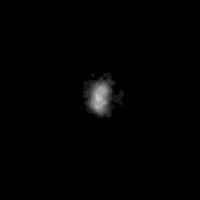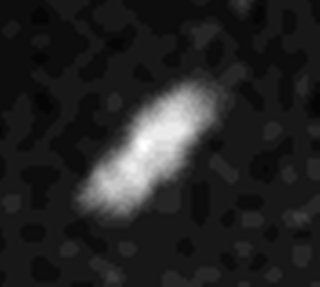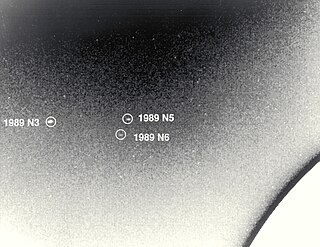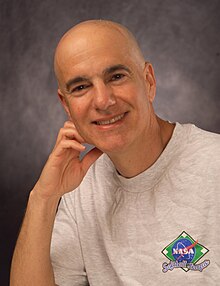
Nereid, or Neptune II, is the third-largest moon of Neptune. Of all known moons in the Solar System, it has the most eccentric orbit. It was the second moon of Neptune to be discovered, by Gerard Kuiper in 1949.

Naiad, named after the naiads of Greek legend, is the innermost satellite of Neptune and the nearest to the center of any gas giant with moons with a distance of 48,224 km from the planet's center. Its orbital period is less than a Neptunian day, resulting in tidal dissipation that will cause its orbit to decay. Eventually it will either crash into Neptune's atmosphere or break up to become a new ring.

A planet is a large astronomical body that is neither a star nor a stellar remnant. There are competing scientific definitions of a "planet". In the dynamicist definition adopted by the International Astronomical Union (IAU), a planet is a non-stellar body that is massive enough to be rounded by its own gravity, that directly orbits a star, and that has cleared its orbital zone of competing objects. The IAU has also declared that there are eight planets in the Solar System, independently of the formal definition. In the geological definition used by most planetologists, a planet is a rounded sub-stellar body, possibly a satellite. In addition to the eight Solar planets accepted by the IAU, these include dwarf planets such as Eris and Pluto and planetary-mass moons. Bodies meeting the geological definition are sometimes called "planetary-mass objects" or "planemos" for short.

Cordelia is the innermost known moon of Uranus. It was discovered from the images taken by Voyager 2 on January 20, 1986, and was given the temporary designation S/1986 U 7. It was not detected again until the Hubble Space Telescope observed it in 1997. Cordelia takes its name from the youngest daughter of Lear in William Shakespeare's King Lear. It is also designated Uranus VI.

Ophelia is a moon of Uranus. It was discovered from the images taken by Voyager 2 on January 20, 1986, and was given the temporary designation S/1986 U 8. It was not seen until the Hubble Space Telescope recovered it in 2003. Ophelia was named after the daughter of Polonius, Ophelia, in William Shakespeare's play Hamlet. It is also designated Uranus VII.

A protoplanetary disk is a rotating circumstellar disc of dense gas and dust surrounding a young newly formed star, a T Tauri star, or Herbig Ae/Be star. The protoplanetary disk may also be considered an accretion disk for the star itself, because gases or other material may be falling from the inner edge of the disk onto the surface of the star. This process should not be confused with the accretion process thought to build up the planets themselves. Externally illuminated photo-evaporating protoplanetary disks are called proplyds.

Thalassa, also known as Neptune IV, is the second-innermost satellite of Neptune. Thalassa was named after sea goddess Thalassa, a daughter of Aether and Hemera from Greek mythology. "Thalassa" is also the Greek word for "sea".

James Barney Pollack was an American astrophysicist who worked for NASA's Ames Research Center.

An ice giant is a giant planet composed mainly of elements heavier than hydrogen and helium, such as oxygen, carbon, nitrogen, and sulfur. There are two ice giants in the Solar System: Uranus and Neptune.
Joseph Burns is a professor at Cornell University with a dual appointment in the Sibley School of Mechanical and Aerospace Engineering (MAE) and the Astronomy department. His primary area of research is dynamics in planetary sciences.
Philip D. Nicholson is an Australian-born professor of astronomy at Cornell University in the Astronomy department specialising in Planetary Sciences. He has been editor-in-chief of the journal Icarus since 1998.

Reta F. Beebe is an American astronomer, author, and popularizer of astronomy. She is an expert on the planets Jupiter and Saturn, and the author of Jupiter: The Giant Planet. She is a professor emeritus in the Astronomy Department at New Mexico State University and 2010 winner of the NASA Exceptional Public Service medal.

David Morrison is an American astronomer, a senior scientist at the Solar System Exploration Research Virtual Institute, at NASA Ames Research Center in Mountain View, California. Morrison is the former director of the Carl Sagan Center for Study of Life in the Universe at the SETI Institute and of the NASA Lunar Science Institute. He is the past Director of Space at NASA Ames. Morrison is credited as a founder of the multi-disciplinary field of astrobiology. Morrison is best known for his work in risk assessment of near Earth objects such as asteroids and comets. Asteroid 2410 Morrison was named in his honor. Morrison is also known for his "Ask an Astrobiologist" series on NASA's website where he provides answers to questions submitted by the public. He has published 12 books and over 150 papers primarily on planetary science, astrobiology and near earth objects.
Dale P. Cruikshank is an astronomer and planetary scientist in the Astrophysics Branch at NASA Ames Research Center. His research specialties are spectroscopy and radiometry of planets and small bodies in the Solar System. These small bodies include comets, asteroids, planetary satellites, dwarf planets, and objects in the region beyond Neptune. He uses spectroscopic observations made with ground-based and space-based telescopes, as well as interplanetary spacecraft, to identify and study the ices, minerals, and organic materials that compose the surfaces of planets and small bodies.

Mark Robert Showalter is a Senior Research Scientist at the SETI Institute. He is the discoverer of six moons and three planetary rings. He is the Principal Investigator of NASA's Planetary Data System Rings Node, a co-investigator on the Cassini–Huygens mission to Saturn, and works closely with the New Horizons mission to Pluto.

Hippocamp, also designated Neptune XIV, is a small moon of Neptune discovered on 1 July 2013. It was found by astronomer Mark Showalter by analyzing archived Neptune photographs the Hubble Space Telescope captured between 2004 and 2009. The moon is so dim that it was not observed when the Voyager 2 space probe flew by Neptune and its moons in 1989. It is about 35 km (20 mi) in diameter, and orbits Neptune in about 23 hours, just under one Earth day. Due to its unusually close distance to Neptune's largest inner moon Proteus, it has been hypothesized that Hippocamp may have accreted from material ejected by an impact on Proteus several billion years ago. The moon was formerly known by its provisional designation S/2004 N 1 until February 2019, when it was formally named Hippocamp, after the mythological sea-horse symbolizing Poseidon in Greek mythology.

Kepler-56b (KOI-1241.02) is a hot Neptune—a class of exoplanets—located roughly 3,060 light-years away. It is somewhat larger than Neptune and orbits its parent star Kepler-56 and was discovered in 2013 by the Kepler Space Telescope.

Lynnae C. Quick, Ph.D. is an American planetary geophysicist and Ocean Worlds Planetary Scientist at NASA Goddard Space Flight Center. Her research centers on theoretical modeling of cryovolcanic processes on the icy moons and dwarf planets in our solar system as well as modeling volcanic activity on Venus and the Moon. Quick is a member of the Dawn, Europa Clipper, and Dragonfly Mission science teams. She is also a member of the NASA Solar System Exploration Research Virtual Institute (SSERVI) Toolbox for Research and Exploration (TREX) team, and serves as co-chair of the Earth and Planetary Systems Sciences section of the National Society of Black Physicists.
Imke de Pater is a Dutch astronomer working at the University of California, Berkeley. She is known for her research on the large planets and led the team using the Keck Telescope to image the 1994 impact of the comet Comet Shoemaker–Levy 9 with Jupiter.















